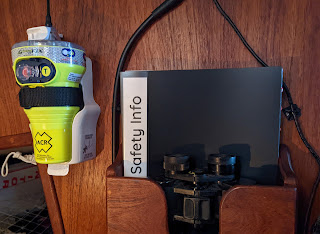Safety Part 2: Onboard De Novo
In the second part of our reassuring-our-parents-we-won't-die series, we look at safety onboard De Novo.
Quick disclaimer. We do what we think is best for our little boat and our situation, but we're not experts. We still have so much to learn. Please feel free to give suggestions. On the other hand, if anything here can help you, great, take it!
Our Safety at Sea training suggested labeling safety gear and making boat-wide safety diagrams. So we did, and we added them below. These drawings help by reminding us of important locations and procedures and familiarizing crew and guests with our boat. By going through the process of making these diagrams, we took the time to make sure all safety items were placed in practical, accessible areas, something we only tangentially thought about beforehand. We don't cover heavy weather sailing in this area (when we reduce sail, heave-to, etc.) because it's pretty individual to the boat and personal comfort. If you'd like to chat about it though, please send us a message!We compiled a safety binder with this information and secured it in the binocular holder near the companionway. We added tabs to get to each section quickly. Don't worry, we don't plan to sit down and sift through the binder during a time-sensitive emergency; if a fire is raging, we're not going to stop to review the fire safety section before putting it out. :) We basically put the binder together for learning, practice, and prevention.
De Novo Diagrams:
 |
| If we were to spring a leak, it would most likely be from thru-hulls. We make a habit of checking them/ exercising valves regularly. |
 |
Abandoning ship is a last resort. We would only deploy the life raft if flooding or a fire couldn't be contained. To be ready though, most items are kept together. We reregister our Emergency Position Indicating Radio Beacon [EPIRB] every two years. If we activate it or it gets submerged in water, it notifies search and rescue services of our exact position. Our IridiumGo is our satellite communication device, used primarily to get weather information. The waterproof ditch bag (aka abandon ship bag) has two possible locations (decided based on whether we're carrying additional crew). A list of our ditch bag contents is here. |
 |
| This section includes a write up of prescription drugs onboard (mostly just antibiotics), a list of all first aid items and locations, and specific first aid charts (for identifying and treating stages of hypothermia in crew overboard rescues, CPR reminders, burn treatments, etc.). As for our marine first aid manual, we've had this one for years and recommend it. |
 |
| Bolt cutters are for rigging and anchor chain emergencies. Thanks to SV Griffin for directing us to small hydraulic cable cutters that fit both our budget and limited storage. |








Comments
Post a Comment